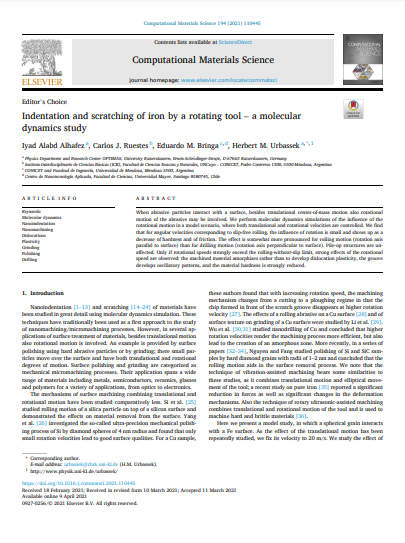Indentation and scratching of iron by a rotating tool-a molecular dynamics study

Fecha
2021-06-15Autor
Bringa, Eduardo M. [Univ Mayor, Fac Ciencias, Ctr Nanotecnol Aplicada, Chile]
Alhafez, Iyad Alabd
Ruestes, Carlos J.
Urbassek, Herbert M.
Ubicación geográfica
Notas
HERRAMIENTAS
Acceda a títulos restringidos
¿Cómo descargar?Resumen
When abrasive particles interact with a surface, besides translational center-of-mass motion also rotational motion of the abrasive may be involved. We perform molecular dynamics simulations of the influence of the rotational motion in a model scenario, where both translational and rotational velocities are controlled. We find that for angular velocities corresponding to slip-free rolling, the influence of rotation is small and shows up as a decrease of hardness and of friction. The effect is somewhat more pronounced for rolling motion (rotation axis parallel to surface) than for drilling motion (rotation axis perpendicular to surface). Pile-up structures are unaffected. Only if rotational speeds strongly exceed the rolling-without-slip limit, strong effects of the rotational speed are observed: the machined material amorphizes rather than to develop dislocation plasticity, the groove develops oscillatory patterns, and the material hardness is strongly reduced.
URI
https://repositorio.umayor.cl/xmlui/handle/sibum/9057https://doi-org.bibliotecadigital.umayor.cl:2443/10.1016/j.commatsci.2021.110445
https://www-sciencedirect-com.bibliotecadigital.umayor.cl:2443/science/article/pii/S0927025621001701/pdfft?md5=71918e228dd7567e435e47717ed9c37b&pid=1-s2.0-S0927025621001701-main.pdf
Coleccion/es a la/s que pertenece:
Si usted es autor(a) de este documento y NO desea que su publicación tenga acceso público en este repositorio, por favor complete el formulario aquí.